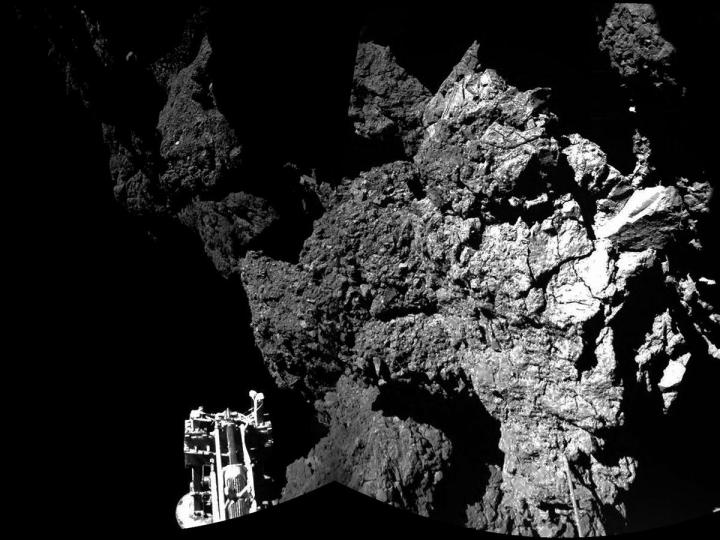
The bad news? The lander craft, named Philae, had a bit of trouble touching down on the comet’s surface, and now, unless the ESA can figure out a way to reposition the lander, the mission might end sooner than expected.
After leaving the Rosetta probe late Tuesday night, Philae began a slow descent to the surface of the comet known as 67P/Churyumov-Gerasimenko. A few hours later, it touched down — but it wasn’t a light landing. Philae’s harpoon system –which was supposed to anchor it to the comet– didn’t work like it was supposed to, and the craft bounced off the rock a couple times before settling onto the surface.
Because it couldn’t anchor itself properly, the lander craft ended up resting in a different section of the comet than originally intended. Right now, only two of its three spindly feet are touching the ground, and it’s resting in a precarious position at the bottom of a cliff. Unfortunately, due to the way the comet spins, the spot Philae is resting at doesn’t get much sunlight — only about 3 hours every 24-hour day. This means that it will have to rely heavily on its battery reserves, which only had about 64 hours worth of power when fully charged.
Essentially, this means that Philae won’t be able to use its drill to analyze the comet’s surface — unless of course the ESA can figure out a way to jostle and reposition the craft before it completely loses power. With such low gravity, drilling without being anchored to the comet’s surface could destabilize the lander and fling it off into space. The drilling system was supposed to gather samples of the ice and dust that 67P is composed of, and compare the hydrogen isotopes in the water to those found in the water here on Earth — but that might not be possible now.
If everything had gone smoothly, the ESA expected the mission to run until sometime around March 2015, when 67P flies close enough to the sun to fry Philae’s electronics. Now, it’s on a much shorter timeline, since it will likely run out of power soon.
There’s still hope though. Mission control is currently considering a number of different plans to reposition the lander, giving its solar panels access to more sunlight. We’ll update this article with new developments, but in the meantime, the best way to keep up with what’s happening is to keep an eye on Philae’s Twitter account, which the ESA updates every few hours.
[images via NASA]
Editors' Recommendations
- ESA satellite in a race against time to dodge space junk
- U.S. astronaut returns home after record-breaking mission
- SpaceX completes 125th successful mission with nighttime booster landing
- SpaceX mission deploys record number of satellites and nails landing
- NASA astronaut Chris Cassidy lands safely after six-month space trip




